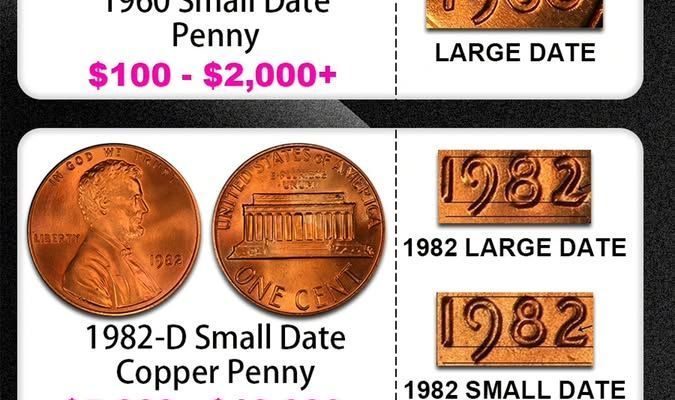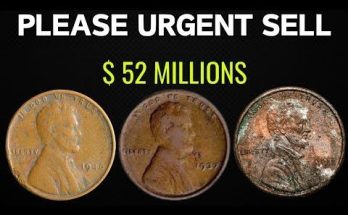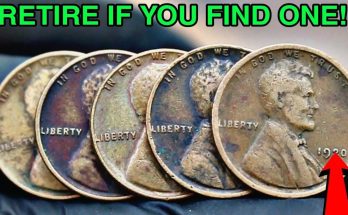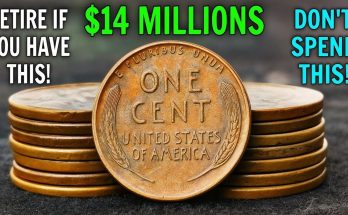In the world of numismatics, the most exciting treasures are not always ancient or exotic. Often, they are hiding in plain sight, tucked away in your piggy bank, or mixed in with the change in your pocket. The adventure of coin collecting begins not with a trip to an auction house, but with the simple act of looking closer. By learning to spot the subtle, hidden details on coins, you can transform a common penny into a valuable piece of history. The Lincoln Memorial penny, minted from 1959 to 2008, is one of the most rewarding coins to search through, as it contains a number of rare varieties and valuable errors that have captivated collectors for decades.
As the image shows, knowing what to look for can be the difference between a one-cent coin and a priceless discovery. Let’s explore some of the most sought-after varieties and errors that turn an ordinary penny into a numismatic prize.
The 1960 Penny: The Tale of Two Dates
In 1960, the U.S. Mint produced the Lincoln cent with two distinctly different types of dates, known as the “Small Date” and “Large Date” varieties. The difference is subtle but crucial. On the “Small Date” penny, the numbers in the “1960” are noticeably smaller, and the “0” appears more oval-shaped. On the “Large Date” variety, the numbers are larger and bolder, and the “0” is rounder.
The reason for these two varieties is tied to a minor hiccup in the minting process, where a different coin die was used for a portion of the production run. The “Small Date” variety is far less common, and in a high-grade, uncirculated condition, it can be worth anywhere from $100 to $2,000 or more, especially for the “D” (Denver) mint mark versions. This simple detail, easily overlooked by a casual observer, is a perfect example of how a small variation can lead to a significant increase in value.
The 1982 Penny: A Confluence of Changes
The year 1982 is a watershed moment for the penny and a true playground for coin collectors. In this year, the U.S. Mint made a critical change in the coin’s composition, switching from a 95% copper alloy to a cheaper copper-plated zinc alloy. This created two distinct types of 1982 pennies: a heavier, bronze version and a lighter, zinc-core version.
But that’s not all. The Mint also produced both a “Large Date” and a “Small Date” variety for the 1982 cent, similar to the 1960 run. This combination of a date variety and a metal composition change created a total of seven different 1982 Lincoln cent varieties, each with its own mintage and value.
The rarest and most valuable of these is the 1982-D Small Date Copper Penny. For reasons that remain a point of discussion among numismatists, a small number of pennies with the “D” mint mark and the “Small Date” were mistakenly struck on the old copper planchets. This coin is an extreme rarity, with only a small number ever discovered. While a standard 1982 penny is worth only face value, a certified 1982-D Small Date copper cent can command a value of $5,000 to over $10,000, making it one of the greatest treasures in modern coinage. A simple digital scale is all you need to begin your search.
The 1995 Penny: Hunting for a Doubled Die
The 1995 Lincoln cent is a fantastic example of a modern, valuable error coin. While billions were produced, a small number were struck with a clear and distinct “doubled die” error. This occurs when the coin’s die receives a misaligned second impression during its creation, causing the lettering on the coin to appear slightly doubled.
On the 1995 Doubled Die penny, this error is most noticeable on the words “LIBERTY” and the motto “IN GOD WE TRUST.” By using a magnifying glass, you can clearly see the ghostly outline of the letters. Unlike some of the rarer varieties, the 1995 Doubled Die penny is a relatively common and accessible find for a collector willing to search through rolls of coins. Still, its popularity and clear visibility make it highly sought after. Depending on the condition, a 1995 Doubled Die can be worth from $50 for a well-circulated coin to over $2,500 for a pristine, uncirculated specimen.
The coin collecting adventure is a rewarding journey that begins with a simple lesson: every coin has a story, and the most valuable ones often have a unique tale to tell. By learning to look for key dates, subtle varieties, and minting errors, you can turn a mundane task into a fascinating treasure hunt. So, grab a magnifying glass, empty that change jar, and start discovering the hidden details of your pennies today.



